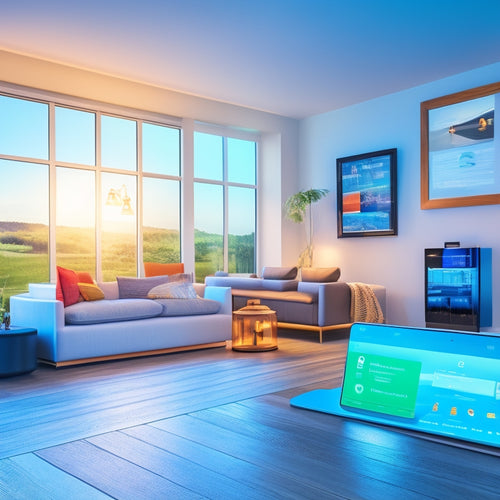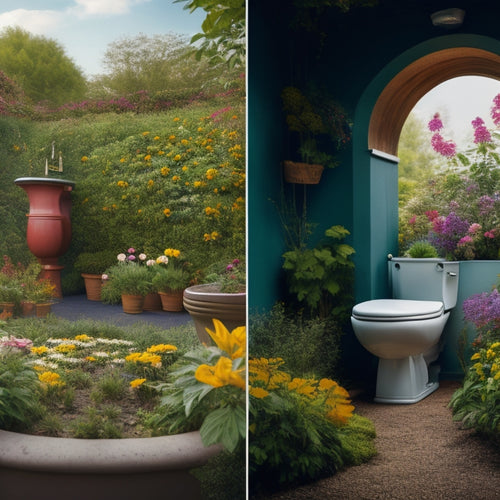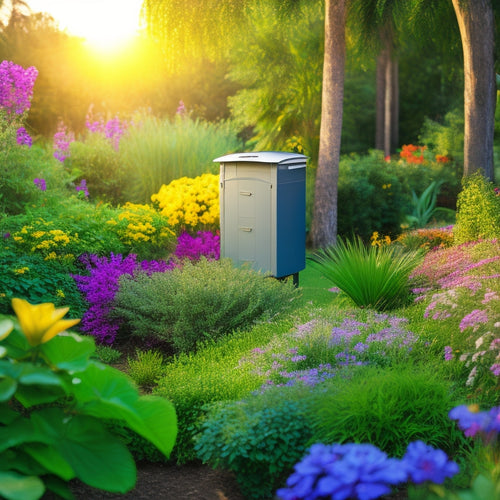
What Water-Saving Gadgets Can Homeowners Use Today?
Share
You can greatly reduce your water consumption and lower your utility bills by leveraging various water-saving gadgets and technologies available in the market today. Smart water meters and leak detection systems help track and identify water waste, while low-flow showerheads and efficient toilet fixtures minimize water usage in your daily routine. Rainwater harvesting solutions and grey water recycling systems offer alternative sources of water, and irrigation controllers with sensors optimize watering schedules. Additionally, various water-saving accessories like faucet aerators and real-time water usage trackers can further enhance your water-saving efforts. By exploring these options, you'll uncover even more innovative ways to conserve water and reduce your environmental footprint.
Key Takeaways
- Smart water meters track real-time water consumption, helping homeowners identify inefficiencies and reduce water waste effectively.
- Leak detection systems monitor water usage continuously, alerting homeowners to potential leaks before significant water loss occurs.
- Low-flow showerhead technology reduces water consumption without sacrificing performance, saving up to 2.5 gallons of water per minute during showers.
- Dual-flush toilet options and low-flow toilet models promote customizable water usage, reducing water per flush compared to traditional toilets.
- Real-time water usage trackers provide instant insights into water consumption patterns, enabling homeowners to monitor and adjust water usage habits effectively.
Smart Water Meters for Homes
Since you're considering ways to enhance your water usage, installing a smart water meter in your home can be a great starting point. This device tracks your water consumption in real-time, providing you with useful observations to develop effective water conservation strategies.
With the increasing adoption of renewable energy sources for EV charging Renewable Energy Sources, it's crucial to investigate innovative solutions for sustainable living.
With a smart water meter, you can identify areas of inefficiency and make data-driven decisions to reduce your water waste. For instance, you can integrate smart irrigation technology to schedule watering sessions during ideal times, ensuring your lawn and garden receive the right amount of water.
Leak Detection Systems Online
You can take your water conservation efforts to the next level with online leak detection systems that constantly monitor your home's water usage.
These systems can detect hidden leaks, alerting you to potential issues before they waste significant amounts of water.
By leveraging fast charging infrastructure, homeowners can also reduce their energy consumption and carbon footprint.
Additionally, integrating energy storage systems can optimize energy efficiency and reduce reliance on traditional power sources.
Detecting Hidden Leaks
Hidden leaks can waste a substantial amount of water, increasing your utility bills and causing damage to your home. You can prevent this by employing advanced leak detection technologies that identify hidden leaks early on.
These systems use sensors and algorithms to detect anomalies in your water usage patterns, alerting you to potential issues before they become major problems.
Electrical infrastructure upgrades, such as those required for EV charging stations, can also help reduce the risk of electrical outages and avoid power demand issues.
By investing in leak detection technologies, you can avert water loss and save money on your utility bills. Furthermore, these systems provide you with peace of mind, knowing that your home is protected from water damage.
Real-Time Water Monitoring
Vigilance is key to catching water leaks before they escalate into costly problems. With real-time water monitoring, you can stay on top of your water usage and identify potential issues before they become major headaches.
Online leak detection systems provide you with water usage analytics, giving you a clear view of your consumption patterns. This allows you to pinpoint areas where you can cut back and make adjustments to reduce waste.
By monitoring your water usage in real-time, you can detect even the smallest leaks and take action to prevent further damage.
Furthermore, understanding the importance of renewable energy sources can also contribute to a more sustainable future. In addition, businesses can also benefit from installing solar-powered charging stations, which can lead to significant energy savings and enhance their sustainability.
This proactive approach gives you the freedom to take control of your water usage and make informed decisions about your household's water consumption.
Smart Home Integration
Real-time water monitoring provides a solid foundation for water conservation, and smart home integration takes it to the next level. With smart home integration, you can control and monitor your water usage remotely, receiving alerts and notifications in case of leaks or unusual activity. This integration allows you to automate water-saving tasks, such as:
| Smart Feature | Description | Benefits |
|---|---|---|
| Smart Irrigation | Automated watering schedules based on weather and soil conditions | Optimizes water usage and reduces waste |
| Automated Faucets | Motion-sensing faucets that turn off when not in use | Reduces water waste and saves energy |
| Leak Detection | Real-time alerts and notifications in case of leaks | Prevents water damage and saves resources |
Low-Flow Showerhead Technology
Installed in millions of homes, low-flow showerheads have become a staple in water-saving technology, with many homeowners reaping the benefits of reduced water consumption without sacrificing performance.
You can choose from various showerhead materials, such as aerodynamic designs, flow restrictors, and vortex flows, which optimize water flow while minimizing usage.
Considering the importance of energy assessment and needs analysis in identifying energy consumption patterns, homeowners can also investigate energy-efficient solutions for their shower systems. By doing so, they can further reduce their environmental footprint.
Pressure compensation technology guarantees a consistent shower experience, even at lower water pressures.
By installing a low-flow showerhead, you can save up to 2.5 gallons of water per minute, without noticing a difference in your daily routine.
With modern designs and materials, you can enjoy a rejuvenating shower while contributing to a more sustainable future.
Efficient Toilet Fixtures Today
You'll find that modern toilets have made noteworthy advancements in water conservation, with options like dual-flush toilet models that allow you to choose between a full or partial flush.
Regular cleaning and maintenance practices such as those used in fleet maintenance can also be applied to toilets to guarantee peak performance and water efficiency.
Additionally, low-flow toilet models are designed to use considerably less water per flush, making them a water-efficient alternative to traditional toilets.
Dual-Flush Toilet Options
The quest for water efficiency in toilets has led to the development of dual-flush toilet options, which have become a staple in modern bathroom fixtures. You can now choose from various toilet design innovations that offer significant flushing efficiency improvements. Dual-flush toilets allow you to select between two different flush volumes, typically 0.8 gallons per flush (gpf) for liquid waste and 1.6 gpf for solid waste. This flexibility enables you to conserve water while still maintaining effective waste removal.
| Dual-Flush Toilet Type | Liquid Waste Flush (gpf) | Solid Waste Flush (gpf) |
|---|---|---|
| Low-Flow Dual-Flush | 0.5 | 1.1 |
| Mid-Flow Dual-Flush | 0.8 | 1.6 |
| High-Efficiency Dual-Flush | 0.3 | 0.8 |
| Pressure-Assisted Dual-Flush | 0.5 | 1.0 |
| Gravity-Fed Dual-Flush | 0.6 | 1.2 |
Low-Flow Toilet Models
By now, homeowners have access to a wide range of low-flow toilet models that boast impressive water-saving capabilities without compromising on performance.
You can expect toilet performance to remain unaffected, while design innovations reduce water consumption. With low-flow toilets, you'll considerably reduce your environmental impact, saving up to 20 gallons of water per day.
When installing, guarantee proper alignment and follow manufacturer guidelines to avoid leaks. You'll reap cost savings from reduced water bills, and user reviews often praise the quiet operation and effectiveness of these toilets.
Regular maintenance is essential, so be sure to follow guidelines for cleaning and inspecting your toilet.
Compare brands like Toto, Kohler, and American Standard to find the best fit for your needs, and prioritize water efficiency while considering consumer preferences.
Toilet Flapper Upgrades
Every three flushes, a traditional toilet flapper can waste up to one gallon of water due to inefficient designs and poor installation. You can upgrade your toilet flapper to a more efficient model, reducing water waste and saving you money on your utility bills.
| Flapper Type | Water Savings | Replacement Frequency |
|---|---|---|
| Traditional | 0% | Every 5-7 years |
| Adjustable | 20-30% | Every 7-10 years |
| Dual-Flush | 30-50% | Every 10-12 years |
| Hydro-Flapper | 50-70% | Every 12-15 years |
| Silent-Flapper | 70-90% | Every 15-18 years |
When selecting a new flapper, consider your toilet's age and usage. Regular toilet maintenance tips include checking for leaks and adjusting the flapper to guarantee proper sealing. Replace your flapper every 5-7 years, or as needed, to sustain peak performance and water efficiency.
Rainwater Harvesting Solutions
How much rainwater could you be reusing if you'd a proper harvesting system in place?
Rainwater harvesting solutions can greatly reduce your water bill and dependence on municipal water supplies. You can implement rain barrel systems, which collect and store rainwater from your rooftop catchment area.
This water can be used for non-potable purposes such as flushing toilets, washing cars, and irrigating your garden. A rooftop catchment system can collect a substantial amount of rainwater, especially during heavy rainfall events.
Grey Water Recycling Systems
You're likely familiar with the concept of reusing water, but have you considered implementing a grey water recycling system in your home?
This system collects and treats wastewater from sinks, showers, and washing machines, making it suitable for irrigation and flushing toilets.
How It Works
A grey water recycling system's operation relies on a network of pipes, pumps, and treatment units that work in tandem to collect, process, and redistribute grey water throughout your home.
This setup enables you to conserve water and adopt sustainable practices. As you use water in your daily activities, the system collects grey water from sinks, showers, and washing machines.
- It then channels the grey water into a treatment unit, where contaminants are removed.
- The treated water is disinfected and filtered to make it safe for reuse.
- The recycled water is stored in a tank for future use.
- You can use the recycled water for irrigation, toilet flushing, and washing machines.
Benefits of Recycling
By installing a grey water recycling system, you tap into a wealth of benefits that extend beyond mere water conservation.
You'll reduce your environmental impact by minimizing the amount of wastewater discharged into sewage systems, thereby decreasing the ecological footprint of your household.
Additionally, you'll enjoy cost savings from reduced water consumption, which can lead to significant long-term savings.
As you adopt sustainable practices, you'll raise community awareness about the importance of resource management and water conservation.
The recycling benefits also extend to your wallet, as you'll reduce your water bills.
System Maintenance Needs
Implementing a grey water recycling system is only the first step; to reap its benefits, regular maintenance is essential to confirm the system operates efficiently and effectively.
You'll need to establish a routine to guarantee your system runs smoothly and doesn't compromise water quality.
To maintain system efficiency, you should:
- Regularly inspect and clean filters to prevent clogging
- Check pipes and connections for signs of wear or damage
- Monitor water quality and adjust the system as needed
- Perform routine backups and system checks to prevent failures
- Schedule regular maintenance according to the manufacturer's guidelines
Water-Saving Faucet Aerators
Frequently, homeowners overlook the humble faucet as a prime opportunity to conserve water, but installing water-saving faucet aerators can make a significant impact.
By attaching these devices to your faucet, you'll experience faucet aerator benefits like reduced water flow rates, which can lead to substantial water savings over time.
When installing, make sure to follow these installation tips: choose an aerator that matches your faucet's thread type, and clean the faucet's aerator screen regularly to maintain peak performance.
With the right aerator, you can enjoy a guilt-free shower or wash dishes without worrying about wasting water.
Irrigation Controllers With Sensors
You've taken the first step towards water conservation by installing water-saving faucet aerators, but now it's time to tackle another significant water-guzzler: your irrigation system.
Upgrading to an irrigation controller with sensors can optimize water distribution, reducing waste and ensuring your plants receive the right amount of water.
These advanced controllers use real-time data from sensors to adjust watering schedules based on factors like:
- Soil moisture levels
- Evapotranspiration rates
- Rainfall
- Temperature
- Humidity
Drought-Resistant Lawn Care Tools
About 30% of residential water is devoted to lawn care, making it a prime target for water conservation. You can make a significant impact by adopting drought-resistant lawn care tools.
Start by incorporating drought-resistant plants into your garden, which require less water and maintenance. Additionally, consider sustainable landscaping practices, such as using mulch and compost, to reduce water evaporation and retain soil moisture.
You can also use tools like lawn aerators and dethatchers to improve soil drainage and reduce water waste. These tools help create a healthier lawn that's more resilient to drought, reducing your water consumption and saving you money on your water bill.
Real-Time Water Usage Trackers
As you focus on optimizing your lawn care to conserve water, it's equally important to monitor your water usage in real-time to identify areas for improvement.
Real-time water usage trackers provide you with instant information into your consumption patterns, enabling you to make informed decisions about your water usage.
With these devices, you can:
- Receive alerts when unusual usage patterns are detected
- Monitor water usage analytics to identify water-wasting habits
- Track water consumption in real-time to optimize your daily routine
- Set customized alerts for specific water usage thresholds
- Integrate with smart home systems for seamless monitoring and control
Frequently Asked Questions
Can Water-Saving Gadgets Increase My Home's Value?
Can you put a price on a clear conscience? By installing water-saving gadgets, you'll not only reduce your environmental footprint but also elevate your home's value through enhanced energy efficiency and undeniable home appeal, making it a coveted gem on the market.
Are Water-Saving Gadgets Compatible With Old Plumbing Systems?
When upgrading to water-saving gadgets, you'll need to assess your plumbing's compatibility, considering factors like pipe material and diameter, to avoid installation concerns that might require costly modifications or even render the devices ineffective.
Do Water-Saving Gadgets Require Frequent Maintenance?
You'll find that most water-saving gadgets require minimal maintenance, but you'll still need to check and clean filters regularly; for troubleshooting tips, consult the user manual or manufacturer's website to guarantee peak performance and freedom from maintenance woes.
Can I Install Water-Saving Gadgets Myself or Need a Professional?
You're not a lone wolf, but with DIY installation, you can tackle some water-saving gadgets, like low-flow showerheads; however, for more complex tasks, like installing greywater systems, it's best to call in the cavalry – Professional services – to guarantee a seamless, leak-free experience.
Are Water-Saving Gadgets Eligible for Government Rebates or Incentives?
You'll want to research government programs offering rebates for water-saving gadgets; you're likely eligible for incentives, but rebate eligibility varies by state and local authorities, so verify the requirements to maximize your savings.
Related Posts
-

10 Best WiFi Outlets for Tracking Home Energy Usage
You can optimize your home's energy usage with the right WiFi outlets, which provide real-time monitoring and control...
-

Why Transform Human Waste Into Garden Gold?
By changing human waste into garden gold, you'll reduce waste management costs, support sustainable agriculture, and ...
-

Why Choose Solar Composting Toilets for Your Home?
By choosing a solar composting toilet for your home, you'll greatly reduce your environmental impact, slashing your w...


